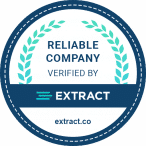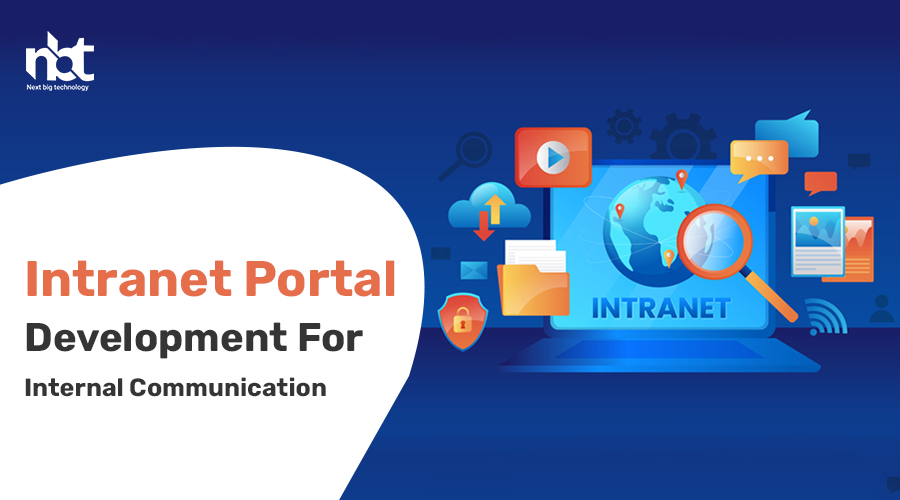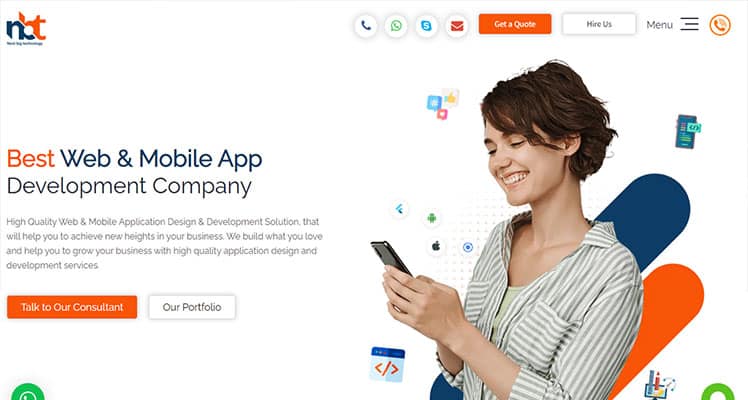Table of Contents
Intranet portal development for internal communication Services
In today’s fast-paced business environment, effective internal communication is paramount to the success of any organization. Seamless communication among employees fosters collaboration, boosts productivity, and ensures everyone is aligned with the company’s goals. Intranet portals have emerged as indispensable tools for facilitating internal communication services, providing a centralized platform for sharing information, collaborating on projects, and connecting employees across departments and locations.
Understanding Intranet Portal Development
An intranet portal serves as a private network within an organization, accessible only to its members. It acts as a hub for various communication and collaboration services, including document sharing, messaging, news updates, employee directories, and more. Developing a robust intranet portal requires careful planning, incorporating the organization’s unique requirements, security protocols, and user interface preferences.
Key Features and Benefits
- Centralized Information Repository: Intranet portals offer a centralized location for storing and accessing critical documents, policies, procedures, and company resources. This ensures that employees can quickly find the information they need, improving efficiency and reducing the time spent searching for documents across disparate systems.
- Enhanced Collaboration: By facilitating real-time communication and collaboration tools such as instant messaging, discussion forums, and project management modules, intranet portals break down silos between departments and enable teams to work together seamlessly. This fosters innovation, accelerates decision-making processes, and promotes a culture of teamwork within the organization.
- Employee Engagement and Empowerment: Intranet portals can serve as platforms for employee engagement initiatives, such as employee recognition programs, feedback mechanisms, and social networking features. By giving employees a voice and fostering a sense of belonging, organizations can boost morale, retention rates, and overall job satisfaction.
- Mobile Accessibility: With the increasing prevalence of remote and distributed teams, mobile accessibility has become crucial for modern intranet portals. Responsive design and dedicated mobile apps enable employees to access the portal from anywhere, anytime, using their smartphones or tablets, ensuring continuous connectivity and productivity.
- Analytics and Insights: Advanced intranet portal solutions offer analytics capabilities that provide valuable insights into user behavior, content engagement, and communication effectiveness. By analyzing these metrics, organizations can optimize their internal communication strategies, identify areas for improvement, and measure the impact of their initiatives.
Best Practices for Intranet Portal Development
- User-Centric Design: Prioritize user experience (UX) design principles to ensure the portal is intuitive, easy to navigate, and visually appealing.
- Customization and Personalization: Allow users to customize their portal experience based on their roles, preferences, and frequently accessed content.
- Robust Security Measures: Implement stringent security measures to safeguard sensitive information and protect against unauthorized access or data breaches.
- Scalability and Flexibility: Build a scalable architecture that can accommodate future growth and evolving business needs, with the flexibility to integrate third-party applications and services.
- Regular Updates and Maintenance: Commit to regular updates, patches, and maintenance to keep the portal secure, performant, and aligned with the organization’s evolving requirements.
How to Create a Intranet portal development for internal communication
In today’s fast-paced corporate world, effective internal communication is paramount to the success of any organization. With teams spread across different locations or even working remotely, establishing a centralized hub for communication and collaboration is essential. This is where an intranet portal comes into play. An intranet portal serves as a virtual workspace where employees can access company information, communicate with colleagues, share documents, and collaborate on projects. In this article, we’ll delve into the process of creating an intranet portal tailored to your organization’s needs.
- Define Your Objectives: Before diving into the technical aspects, it’s crucial to outline the objectives of your intranet portal. What do you aim to achieve with this platform? Whether it’s improving internal communication, enhancing collaboration, or centralizing resources, clearly defining your goals will guide the development process.
- Understand User Needs: Conduct thorough research to understand the needs and preferences of your employees. What features are essential for seamless communication and collaboration? Consider factors such as user-friendly interface, mobile accessibility, integration with existing tools, and personalized content.
- Select the Right Platform: Choose a platform that aligns with your requirements and budget. Options range from open-source solutions like SharePoint and WordPress to custom-built intranet software. Evaluate each platform based on factors such as scalability, security, customization options, and ongoing support.
- Design a User-Friendly Interface: The success of your intranet portal hinges on its usability. Design a clean and intuitive interface that facilitates easy navigation and access to information. Incorporate features like customizable dashboards, quick links, and search functionality to enhance user experience.
- Implement Essential Features: Identify the core features that are essential for internal communication and collaboration. This may include:
- News and Announcements: Keep employees informed about company updates, events, and news.
- Document Management: Enable seamless sharing, storage, and version control of documents and files.
- Discussion Forums: Foster dialogue and knowledge-sharing among employees through discussion forums or message boards.
- Employee Directory: Provide a centralized directory with profiles and contact information for easy communication.
- Task Management: Streamline project collaboration with task management tools, enabling teams to assign tasks, track progress, and set deadlines.
- Integration with Other Tools: Integrate with existing tools such as email, calendar, and productivity suites for a seamless workflow.
- Ensure Security and Compliance: Security should be a top priority when developing an intranet portal. Implement robust security measures to protect sensitive information and ensure compliance with data privacy regulations. This may involve encryption, user authentication, access controls, and regular security audits.
- Provide Ongoing Support and Training: Launching the intranet portal is just the beginning. Provide comprehensive training to employees to familiarize them with the platform and its features. Additionally, offer ongoing support to address any technical issues or user queries that may arise.
- Gather Feedback and Iterate: Solicit feedback from employees to identify areas for improvement and iterate on the intranet portal accordingly. Regularly assess user satisfaction, usage patterns, and engagement metrics to refine the platform and enhance its effectiveness.
Why Should You Go for Intranet portal development for internal communication
In today’s fast-paced business landscape, effective internal communication is crucial for the success of any organization. As companies expand and teams become more distributed, the need for a centralized platform to streamline communication becomes increasingly evident. This is where intranet portal development steps in, offering a tailored solution to meet the unique communication needs of modern businesses.
So, why should you consider investing in intranet portal development for internal communication? Let’s delve into some compelling reasons:
- Centralized Communication Hub: An intranet portal serves as a centralized hub for all internal communications. It provides employees with a single platform where they can access company news, updates, documents, and resources without having to sift through numerous channels or emails. This centralized approach enhances efficiency and ensures that everyone is on the same page.
- Improved Collaboration: Collaboration lies at the heart of any successful organization. Intranet portals facilitate collaboration by enabling employees to share ideas, collaborate on projects, and engage in discussions regardless of their location. Features such as document sharing, version control, and team workspaces foster a collaborative work environment, leading to increased productivity and innovation.
- Enhanced Information Accessibility: Traditional communication methods like email can often lead to information overload and make it challenging for employees to find the information they need. Intranet portals address this issue by providing a user-friendly interface where information is organized and easily accessible. Whether it’s company policies, training materials, or project updates, employees can quickly locate the information they require, thus saving time and minimizing frustration.
- Real-Time Updates and Notifications: Keeping employees informed in real-time is essential for ensuring that everyone stays up-to-date with the latest developments. Intranet portals offer features such as push notifications and news feeds, allowing organizations to disseminate important updates instantly. Whether it’s a company-wide announcement, a policy change, or a project milestone, employees receive timely notifications, fostering transparency and accountability.
- Customization and Scalability: One of the key advantages of intranet portal development is its flexibility and scalability. Organizations can customize the portal to align with their specific needs and branding guidelines. Whether it’s adding custom modules, integrating third-party applications, or incorporating personalized features, intranet portals can be tailored to suit the unique requirements of different departments and teams. Furthermore, as the organization grows, the intranet portal can scale seamlessly to accommodate additional users and functionalities.
- Data Security and Compliance: With the increasing emphasis on data security and compliance, organizations need robust solutions to safeguard sensitive information. Intranet portals offer advanced security features such as role-based access control, encryption, and audit trails, ensuring that confidential data remains protected at all times. Moreover, intranet portals can help organizations adhere to regulatory requirements such as GDPR or HIPAA by providing compliance features and reporting capabilities.
- Employee Engagement and Satisfaction: An engaging work environment is essential for attracting and retaining top talent. Intranet portals play a vital role in fostering employee engagement by providing avenues for interaction, recognition, and feedback. Features like employee directories, discussion forums, and social networking tools promote a sense of belonging and community within the organization, leading to higher job satisfaction and employee retention.
Market Prospects of Custom Intranet portal development for internal communication and Platforms
In today’s fast-paced business environment, effective internal communication plays a pivotal role in the success of any organization. With teams scattered across various locations and remote work becoming more prevalent, the need for robust internal communication platforms has never been more significant. Custom intranet portals emerge as a solution tailored to meet the unique needs of businesses, providing a centralized hub for communication, collaboration, and information sharing. Let’s delve into the market prospects of custom intranet portal development and explore why businesses are increasingly turning towards these platforms.
1. Tailored Solutions for Diverse Needs: Off-the-shelf solutions may offer basic features, but they often fall short in addressing the specific requirements of businesses. Custom intranet portals, on the other hand, can be designed and developed to cater to the unique needs of each organization. Whether it’s integrating with existing systems, implementing specific workflows, or incorporating brand elements, customization ensures that the intranet aligns seamlessly with the company’s operations and culture.
2. Enhanced Collaboration and Productivity: Effective collaboration is the cornerstone of success in any organization. Custom intranet portals facilitate seamless communication and collaboration among team members, regardless of their location. Features such as instant messaging, file sharing, project management tools, and discussion forums streamline workflow and foster teamwork. By centralizing communication channels and resources, these platforms empower employees to work more efficiently, leading to improved productivity and performance.
3. Data Security and Compliance: Data security is a top priority for businesses, especially when it comes to internal communications. Custom intranet portals offer enhanced security measures, including role-based access controls, encryption protocols, and regular security updates. Moreover, these platforms can be tailored to ensure compliance with industry regulations and data protection laws, providing peace of mind to organizations handling sensitive information.
4. Scalability and Flexibility: As businesses grow and evolve, so do their communication needs. Custom intranet portals offer scalability and flexibility, allowing organizations to adapt and expand their internal communication infrastructure as required. Whether it’s adding new features, accommodating a larger user base, or integrating with third-party applications, custom solutions can be easily scaled to meet changing business demands.
5. Competitive Edge and Brand Differentiation: In today’s competitive landscape, differentiation is key to standing out in the market. Custom intranet portals provide an opportunity for businesses to differentiate themselves by offering unique features and functionalities tailored to their specific requirements. Moreover, a well-designed and branded intranet portal can enhance employee engagement, reinforce company culture, and showcase the organization’s commitment to innovation and excellence.
6. Future Growth Opportunities: The market for custom intranet portal development is poised for significant growth in the coming years. As more businesses recognize the importance of effective internal communication and collaboration, the demand for tailored solutions will continue to rise. Additionally, advancements in technology, such as artificial intelligence and machine learning, present exciting opportunities to further enhance the capabilities of intranet portals, driving innovation and adoption across industries.
Essential Features of a Intranet portal development for internal communication
In today’s interconnected digital age, effective internal communication is crucial for the smooth operation of any organization. An intranet portal serves as the backbone of internal communication, providing employees with a centralized platform for sharing information, collaborating on projects, and staying connected with colleagues. However, not all intranet portals are created equal. To ensure optimal functionality and usability, certain essential features must be incorporated into the development process.
- User-Friendly Interface: One of the primary considerations in intranet portal development is creating a user-friendly interface. The interface should be intuitive, visually appealing, and easy to navigate, ensuring that employees can quickly access the information they need without encountering any hurdles. A clean layout, organized menus, and straightforward search functionality contribute to a positive user experience.
- Secure Authentication and Access Control: Security is paramount when it comes to internal communication within an organization. A robust authentication system, such as single sign-on (SSO) or multi-factor authentication (MFA), should be implemented to verify user identities and prevent unauthorized access. Additionally, access control mechanisms enable administrators to define user permissions based on roles and responsibilities, ensuring that sensitive information remains protected.
- Document Management: An effective intranet portal should serve as a centralized repository for documents and files, allowing employees to easily upload, share, and collaborate on content. Advanced document management features, such as version control, document tracking, and permission settings, enhance productivity and streamline workflows. Integration with cloud storage services like Google Drive or SharePoint further enhances accessibility and scalability.
- Communication Tools: Facilitating seamless communication among employees is a key objective of an intranet portal. Integration with various communication tools, such as instant messaging, video conferencing, and discussion forums, enables real-time collaboration regardless of geographical locations. Additionally, features like announcements, newsletters, and event calendars keep employees informed about important updates and events within the organization.
- Mobile Compatibility: In today’s mobile-centric world, ensuring compatibility with smartphones and tablets is essential for an intranet portal. A responsive design that adapts to different screen sizes and operating systems allows employees to access the portal anytime, anywhere, enhancing flexibility and productivity. Mobile apps tailored for iOS and Android devices further optimize the user experience and facilitate on-the-go communication.
- Analytics and Reporting: Tracking usage metrics and gathering insights into employee engagement are critical for optimizing the intranet portal’s effectiveness. Built-in analytics tools provide administrators with valuable data on user activity, content consumption, and engagement levels, enabling them to identify trends, measure performance, and make informed decisions for continuous improvement.
- Customization and Integration: Every organization has unique requirements and workflows that need to be accommodated within the intranet portal. Customization options, such as customizable dashboards, branding elements, and integration with third-party applications, allow organizations to tailor the portal to their specific needs and enhance user adoption. Seamless integration with existing systems, such as CRM software or project management tools, further streamlines processes and enhances productivity.
Advanced Features Intranet portal development for internal communication
In today’s fast-paced corporate landscape, effective internal communication is not just a necessity but a strategic imperative. To foster seamless collaboration, boost productivity, and streamline workflows, companies are increasingly turning towards advanced features in intranet portal development. These sophisticated tools offer a plethora of functionalities designed to elevate internal communication to new heights. Let’s delve into some of the cutting-edge features reshaping the landscape of intranet portal development:
- Customization and Personalization: Tailoring the intranet portal to suit the specific needs and preferences of different user groups is crucial. Advanced intranet solutions empower users to customize their dashboards, layouts, and content preferences, ensuring a personalized experience. This enhances user engagement and makes information access more intuitive.
- Mobile Accessibility: With remote work becoming more prevalent, mobile accessibility is no longer a luxury but a necessity. Modern intranet portals are designed with responsive interfaces, allowing seamless access from various devices such as smartphones and tablets. This enables employees to stay connected and productive while on the go.
- Social Collaboration Tools: Integration of social collaboration tools within the intranet portal facilitates dynamic communication and knowledge sharing among employees. Features like discussion forums, activity streams, and instant messaging foster a culture of collaboration, driving innovation and idea generation across the organization.
- Document Management and Version Control: Efficient document management is essential for maintaining data integrity and ensuring information accessibility. Advanced intranet portals offer robust document management capabilities, including version control, document tagging, and advanced search functionalities. This streamlines document workflows and enhances collaboration on shared files.
- Integration with Enterprise Systems: Seamless integration with existing enterprise systems such as CRM, ERP, and HRMS is critical for maximizing the utility of the intranet portal. Advanced solutions offer APIs and connectors that facilitate smooth data exchange between disparate systems, enabling a unified view of organizational data and processes.
- Advanced Analytics and Reporting: Data-driven insights play a pivotal role in optimizing internal communication strategies. Advanced intranet portals come equipped with sophisticated analytics and reporting tools that provide valuable insights into user engagement, content performance, and collaboration patterns. This enables organizations to refine their communication strategies and drive continuous improvement.
- Security and Compliance Features: Protecting sensitive information and ensuring regulatory compliance are paramount concerns for organizations. Advanced intranet portals employ robust security measures such as role-based access control, encryption, and audit trails to safeguard confidential data. Additionally, compliance features help organizations adhere to industry regulations and standards.
- AI-Powered Intelligent Features: Leveraging artificial intelligence (AI) and machine learning algorithms, advanced intranet portals offer intelligent features such as smart content recommendations, automated content tagging, and virtual assistants. These AI-powered capabilities enhance user experience, boost productivity, and streamline information discovery.
Intranet portal development for internal communication Timelines
In today’s fast-paced business environment, effective internal communication is paramount for the smooth functioning of any organization. With teams spread across various locations or working remotely, having a centralized platform for communication and collaboration is no longer just a luxury but a necessity. This is where the development of an intranet portal comes into play, offering a comprehensive solution to streamline internal communication processes. In this article, we delve into the significance of intranet portal development and the key considerations for establishing timelines in this endeavor.
Understanding the Need for Intranet Portal Development:
- Centralized Communication Hub: An intranet portal serves as a centralized hub where employees can access important information, documents, announcements, and updates. It eliminates the need for scattered communication channels, ensuring that everyone is on the same page.
- Enhanced Collaboration: By providing tools for collaboration such as document sharing, project management, and discussion forums, an intranet portal fosters teamwork and productivity among employees irrespective of their physical location.
- Improved Knowledge Management: Intranet portals allow organizations to create and maintain knowledge repositories, making it easier for employees to access relevant resources and information whenever they need it. This promotes continuous learning and knowledge sharing within the organization.
- Streamlined Processes: From leave requests to expense approvals, intranet portals can automate various administrative processes, reducing manual effort and minimizing errors. This not only saves time but also enhances efficiency across departments.
Key Considerations for Developing an Intranet Portal:
- Define Objectives and Requirements: Before embarking on the development process, it’s essential to clearly define the objectives of the intranet portal and identify the specific features and functionalities required to meet the organization’s needs.
- User-Centric Design: The success of an intranet portal hinges on its usability and user experience. Therefore, it’s crucial to involve end-users in the design process and ensure that the portal is intuitive, visually appealing, and accessible across devices.
- Data Security and Compliance: Given the sensitive nature of internal information, security should be a top priority in intranet portal development. Implement robust security measures to safeguard data and ensure compliance with relevant regulations such as GDPR.
- Integration with Existing Systems: To maximize efficiency, the intranet portal should seamlessly integrate with other existing systems and applications used within the organization, such as CRM software, HR management systems, and document repositories.
Establishing Timelines for Intranet Portal Development:
- Requirement Gathering and Analysis: The initial phase involves gathering requirements from stakeholders, analyzing existing systems, and defining the scope of the project. This stage typically takes 2-4 weeks depending on the complexity of the organization’s needs.
- Design and Prototyping: Once the requirements are finalized, the design phase begins, where wireframes and prototypes are created to visualize the layout and functionality of the intranet portal. This phase may take 4-6 weeks to complete.
- Development and Testing: The actual development of the intranet portal takes place in this stage, followed by rigorous testing to identify and rectify any bugs or issues. Depending on the size and complexity of the portal, this phase can span anywhere from 8-12 weeks.
- Deployment and Training: After thorough testing, the intranet portal is deployed to the production environment, and training sessions are conducted to familiarize employees with its features and usage. This phase typically takes 2-4 weeks.
- Ongoing Maintenance and Support: Post-deployment, regular maintenance and support are essential to ensure the smooth functioning of the intranet portal. This includes software updates, bug fixes, and user support, which may be an ongoing process.
How Much Does It Cost to Intranet portal development for internal communication?
In today’s interconnected business landscape, effective internal communication is crucial for the seamless operation of any organization. Intranet portals have emerged as powerful tools for facilitating communication, collaboration, and information sharing among employees within a company. However, one common question that arises when considering implementing an intranet portal is: How much does it cost?
The cost of intranet portal development can vary significantly depending on various factors, including the size and complexity of the organization, the features and functionalities required, customization needs, integration with existing systems, and ongoing maintenance and support. Let’s delve into these factors to understand the potential cost implications:
- Size and Complexity of the Organization:
- The number of users accessing the intranet portal and the complexity of organizational structure play a significant role in determining costs. Larger organizations with diverse departments and geographically dispersed teams may require more robust and scalable solutions, leading to higher development costs.
- Features and Functionalities:
- The cost of intranet portal development largely depends on the features and functionalities desired. Basic features such as employee directories, news and announcements, document management, and messaging capabilities are typically included in most intranet solutions. However, additional features like workflow automation, task management, integration with third-party applications, and advanced analytics may incur extra costs.
- Customization Needs:
- Organizations often have unique requirements and branding guidelines that necessitate customization of the intranet portal interface and functionality. Customization can range from simple branding adjustments to developing tailor-made modules and integrations, which can increase development costs.
- Integration with Existing Systems:
- Integration with existing systems such as HR software, CRM platforms, or enterprise resource planning (ERP) systems may be necessary to ensure seamless data flow and functionality across the organization. The complexity of integration requirements can impact development costs, especially if APIs need to be developed or third-party integration tools are required.
- Ongoing Maintenance and Support:
- It’s essential to consider the long-term costs associated with maintaining and supporting the intranet portal after deployment. This includes regular updates, security patches, technical support, and user training. Organizations may choose to outsource maintenance and support services to a third-party provider or allocate internal resources, which can affect overall costs.
While it’s challenging to provide a one-size-fits-all answer to the cost of intranet portal development, as it varies based on individual organizational needs, a rough estimate can range from several thousand to several hundred thousand dollars. It’s advisable for organizations to conduct a thorough needs assessment, solicit proposals from reputable vendors, and carefully evaluate cost-benefit considerations before embarking on an intranet portal development project.
How to Create a Intranet portal development for internal communication – Team and Tech Stack
In today’s fast-paced business environment, effective communication within organizations is paramount for success. One powerful tool that facilitates this communication is an intranet portal. An intranet portal serves as a centralized hub for sharing information, collaborating on projects, and fostering a sense of community among employees. In this guide, we’ll explore how to create an intranet portal tailored to your organization’s needs, focusing on both the team and the technology stack required for its development.
Understanding the Purpose and Objectives:
Before diving into the technical aspects, it’s crucial to understand the purpose and objectives of your intranet portal. Consider the specific needs of your organization, such as improving internal communication, streamlining processes, enhancing collaboration, and boosting employee engagement. Clearly defining these objectives will guide the development process and ensure that the final product aligns with your organization’s goals.
Assembling the Right Team:
Creating a successful intranet portal requires collaboration across multiple disciplines. Here are key roles that should be represented on your intranet development team:
- Project Manager: Responsible for overseeing the entire development process, coordinating tasks, managing timelines, and ensuring that the project stays on track.
- UX/UI Designer: Designs the user interface and experience of the intranet portal, ensuring it is intuitive, visually appealing, and easy to navigate.
- Developers: Backend and frontend developers who are proficient in the selected technology stack and responsible for building and implementing the intranet portal.
- Content Creators: Develops and curates content for the portal, including news updates, company announcements, and internal resources.
- System Administrators: Manages the technical infrastructure of the intranet portal, including server maintenance, security, and user permissions.
Selecting the Right Technology Stack:
Choosing the appropriate technology stack is crucial for the successful development and deployment of your intranet portal. Here are some key considerations:
- Backend Development: Consider using robust frameworks such as Django, Ruby on Rails, or Node.js for backend development. These frameworks provide scalability, security, and flexibility, allowing you to build complex features and integrate with other systems seamlessly.
- Frontend Development: Opt for modern frontend technologies like React, Angular, or Vue.js to create a responsive and interactive user interface. These frameworks offer component-based architecture, making it easier to manage and maintain the frontend codebase.
- Database Management: Choose a reliable database system such as MySQL, PostgreSQL, or MongoDB to store and manage data efficiently. Consider factors like scalability, performance, and data integrity when selecting the database technology.
- Integration and APIs: Ensure seamless integration with existing systems and applications within your organization, such as CRM software, document management systems, and HR platforms. Utilize RESTful APIs and web services for efficient data exchange and interoperability.
- Security and Compliance: Prioritize security measures such as encryption, authentication, and access control to safeguard sensitive information stored on the intranet portal. Compliance with data protection regulations such as GDPR and HIPAA is essential to maintain trust and confidentiality.
Development and Deployment:
Once the team and technology stack are in place, it’s time to kick off the development process. Adopt agile methodologies such as Scrum or Kanban to iteratively build and test the intranet portal. Encourage regular feedback from stakeholders and end-users to ensure that the portal meets their needs and expectations.
After development, thoroughly test the intranet portal to identify and address any bugs or issues. Conduct user acceptance testing (UAT) to validate the functionality and usability of the portal before deployment.
Intranet portal development for internal communication Process
In today’s fast-paced corporate landscape, effective internal communication stands as a cornerstone for organizational success. As businesses expand geographically and teams become increasingly distributed, the need for seamless information exchange becomes paramount. In this regard, the development of an intranet portal emerges as a transformative solution, facilitating streamlined communication processes and fostering collaboration among employees.
Understanding the Essence of an Intranet Portal:
An intranet portal serves as a private network within an organization, accessible only to its members. It acts as a centralized hub, consolidating various communication channels, resources, and tools essential for day-to-day operations. Unlike traditional communication mediums, such as emails or bulletin boards, an intranet portal offers dynamic features tailored to meet the evolving needs of modern workplaces.
Key Components of Intranet Portal Development:
- User-friendly Interface: A well-designed user interface is imperative for ensuring user adoption and engagement. Intuitive navigation, visually appealing layouts, and personalized dashboards enhance the overall user experience, encouraging active participation.
- Information Management: Centralized storage and organization of documents, policies, and procedures simplify information retrieval and promote consistency across the organization. Version control mechanisms and search functionalities further optimize content accessibility.
- Collaboration Tools: Integration of collaborative tools, such as discussion forums, instant messaging, and project management applications, fosters real-time interaction and teamwork among employees irrespective of their geographical locations.
- Customization and Personalization: Tailoring the portal to reflect the organization’s branding and culture instills a sense of belongingness among employees. Personalized content recommendations and customizable user profiles enhance user satisfaction and engagement.
- Security Measures: Implementation of robust security protocols, including user authentication, role-based access control, and data encryption, safeguards sensitive information and ensures compliance with regulatory requirements.
Benefits of Intranet Portal Development:
- Improved Communication: By providing a centralized platform for communication, an intranet portal eliminates communication silos and facilitates transparent information sharing across departments and hierarchical levels.
- Enhanced Collaboration: Seamless integration of collaborative tools promotes cross-functional collaboration, accelerates decision-making processes, and fosters innovation through knowledge sharing and ideation.
- Increased Productivity: Quick access to relevant information, streamlined workflows, and reduced email clutter result in enhanced productivity and efficiency among employees, allowing them to focus on value-added tasks.
- Employee Engagement: Interactive features, such as social networking capabilities, employee recognition programs, and feedback mechanisms, promote employee engagement and foster a sense of community within the organization.
- Cost Savings: By reducing reliance on traditional communication channels and optimizing resource allocation, intranet portal development leads to cost savings in terms of time, resources, and operational expenses.
Next Big Technology – Your Trusted Intranet portal development for internal communication Partner
In today’s fast-paced digital era, effective internal communication is the cornerstone of organizational success. As businesses continue to evolve, the need for streamlined communication channels within the workplace becomes increasingly vital. Enter Next Big Technology – your trusted partner in developing innovative intranet portals tailored to meet your organization’s unique needs.
Gone are the days of relying solely on traditional modes of communication like emails and bulletin boards. Modern workplaces require dynamic platforms that foster collaboration, enhance productivity, and promote seamless information exchange among employees. This is where Next Big Technology steps in, offering cutting-edge solutions designed to revolutionize your internal communication processes.
With Next Big Technology’s intranet portal development services, you can expect a customized approach that aligns perfectly with your organization’s objectives. Whether you’re a small startup or a large corporation, our team of skilled developers is committed to delivering solutions that cater to your specific requirements.
One of the key advantages of partnering with Next Big Technology is our unwavering commitment to quality and reliability. We understand that your intranet portal serves as the backbone of your internal communication infrastructure, and as such, it must be robust, secure, and user-friendly. Our developers leverage the latest technologies and best practices to ensure that your portal not only meets but exceeds industry standards.
Moreover, our intranet portals are designed with scalability in mind, allowing your organization to adapt and grow seamlessly over time. Whether you’re expanding your team, adding new departments, or integrating additional features, our portals can accommodate your evolving needs without compromising performance.
Security is another paramount concern when it comes to internal communication within organizations. At Next Big Technology, we prioritize the confidentiality and integrity of your data by implementing stringent security measures throughout the development process. From encryption protocols to access controls, we employ a multi-layered approach to safeguard your sensitive information from unauthorized access or breaches.
In addition to enhanced security features, our intranet portals boast intuitive interfaces that facilitate seamless navigation and usability. With user-friendly dashboards, interactive widgets, and personalized content feeds, employees can quickly access the information they need, collaborate with colleagues, and stay informed about company updates – all from a centralized platform.
Furthermore, Next Big Technology’s intranet portals are fully customizable, allowing you to tailor the interface and functionality to suit your organization’s unique culture and branding guidelines. Whether you prefer a sleek and minimalist design or a vibrant and engaging layout, our developers can bring your vision to life with precision and flair.
Enterprise Intranet portal development for internal communication
In today’s fast-paced business landscape, effective internal communication is paramount for the success of any organization. With teams spread across different locations and working remotely becoming increasingly common, having a centralized platform for communication and collaboration is essential. This is where enterprise intranet portal development plays a crucial role.
An enterprise intranet portal serves as a secure, centralized hub where employees can access important information, collaborate on projects, and communicate with one another. It acts as a digital workspace that fosters seamless interaction and enhances productivity within the organization. Here’s why investing in the development of an enterprise intranet portal is beneficial:
- Centralized Information Hub: An intranet portal serves as a one-stop destination for all internal information, including company policies, procedures, documents, and announcements. Instead of sifting through countless emails or searching across different platforms, employees can easily find the information they need within the portal.
- Improved Collaboration: Collaboration is key to driving innovation and achieving organizational goals. With features like document sharing, project management tools, and discussion forums, an intranet portal encourages collaboration among teams regardless of their physical location. This fosters a sense of teamwork and allows for more efficient project management.
- Enhanced Communication: Effective communication is the backbone of any successful organization. An intranet portal provides various communication channels such as instant messaging, video conferencing, and discussion boards, enabling real-time communication among employees. This not only streamlines communication but also reduces the reliance on email, leading to faster decision-making processes.
- Employee Engagement: Engaged employees are more productive, innovative, and loyal to their organization. An intranet portal can help boost employee engagement by providing features such as employee directories, social networking capabilities, and recognition programs. It creates a sense of community and belongingness among employees, leading to higher job satisfaction and retention rates.
- Customization and Scalability: Every organization has unique needs and requirements. A well-designed intranet portal can be customized to align with the specific goals and workflows of the organization. Furthermore, it should be scalable to accommodate future growth and technological advancements, ensuring that it remains relevant and effective in the long run.
- Enhanced Security: Security is a top priority when it comes to internal communication and data sharing. An intranet portal offers robust security features such as user authentication, encryption, and access controls to safeguard sensitive information. This ensures that confidential data remains protected from unauthorized access or cyber threats.
Top Intranet portal development for internal communication Companies
In today’s fast-paced corporate landscape, effective internal communication is paramount for success. As businesses expand globally and teams become more distributed, the need for seamless information flow within organizations has never been greater. This is where top-notch intranet portal development comes into play, offering companies a centralized platform for streamlined communication, collaboration, and information sharing among employees.
What exactly is an intranet portal? Simply put, it’s a private network accessible only to authorized users within an organization. Unlike the public internet, intranets are secure and tailored specifically to meet the needs of the company. They serve as a one-stop destination for employees to access company news, documents, resources, and tools, all in one centralized location.
Now, let’s delve into why investing in a robust intranet portal is crucial for companies looking to enhance their internal communication:
-
-
Next Big Technology:
Next Big Technology is one of the top development companies for the high-quality development of mobile apps and web development services. They have having experienced in-house team of developers who provide top-notch development services according to the business requirements. NBT provides highly business-oriented services and implements all the latest and trending tools and technologies. They always work hard to deliver a top-notch solution at an affordable cost. They are having experience of more than 13 years and delivered lots of projects around the globe to businesses and clients.
NBT is highly focused on providing top-notch development solutions at a very affordable cost. By using their market experience and development experience, they are delivering proper solutions to clients and various industries for their custom requirements.
Location: India, USA, UK, Australia
Hourly Rate :< $25 per Hour
Employees: 50 – 249
Focus Area
- Mobile App Development
- App Designing (UI/UX)
- Software Development
- Web Development
- AR & VR Development
- Big Data & BI
- Cloud Computing Services
- DevOps
- E-commerce Development
Industries Focus
- Art, Entertainment & Music
- Business Services
- Consumer Products
- Designing
- Education
- Financial & Payments
- Gaming
- Government
- Healthcare & Medical
- Hospitality
- Information Technology
- Legal & Compliance
- Manufacturing
- Media
-
- Enhanced Collaboration: Collaboration lies at the heart of any successful organization. With an intranet portal, teams can collaborate more effectively regardless of their physical location. Features such as document sharing, project management tools, discussion forums, and real-time messaging facilitate seamless collaboration among employees, leading to increased productivity and innovation.
- Improved Communication: Clear and transparent communication is key to fostering a positive work environment. Intranet portals provide various communication channels, including company-wide announcements, departmental newsfeeds, and instant messaging, enabling employees to stay informed and connected. Additionally, integrated feedback mechanisms allow for open dialogue between management and staff, promoting a culture of trust and engagement.
- Customization and Scalability: Every organization is unique, with its own set of requirements and workflows. The beauty of intranet portal development lies in its flexibility and scalability. Whether you’re a small startup or a multinational corporation, intranet solutions can be tailored to suit your specific needs and scale alongside your business. From customizable dashboards to personalized user permissions, the possibilities are endless.
- Data Security and Compliance: In an era of increasing data breaches and regulatory requirements, data security is non-negotiable. Unlike public cloud-based platforms, intranet portals offer a higher level of security and control over sensitive company information. With features such as role-based access control, encryption, and regular security updates, intranets provide peace of mind knowing that your data is protected and compliant with industry regulations.
FAQs on Intranet portal development for internal communication
In today’s fast-paced corporate world, effective internal communication is the backbone of organizational success. With the emergence of digital solutions, intranet portals have become a vital tool for fostering seamless communication and collaboration within companies. However, the process of developing an intranet portal can often seem daunting, prompting numerous questions. To demystify this process, let’s delve into some frequently asked questions (FAQs) surrounding intranet portal development for internal communication.
- What exactly is an intranet portal? An intranet portal is a private network accessible only to authorized users within an organization. It serves as a centralized platform for sharing information, resources, and tools, facilitating internal communication and collaboration among employees.
- Why is it essential for organizations to invest in an intranet portal? Investing in an intranet portal offers numerous benefits, including enhanced communication, streamlined access to information, improved employee engagement, increased productivity, and seamless collaboration across departments and teams.
- What are the key features to consider during intranet portal development? Some essential features to consider include:
- User-friendly interface
- Secure access controls
- Customizable dashboards
- Document management system
- News and announcements section
- Collaboration tools (such as chat, forums, and wikis)
- Integration with existing systems (like HRIS and CRM)
- Mobile responsiveness
- How long does it take to develop an intranet portal? The timeline for intranet portal development can vary depending on factors such as the complexity of the portal, customization requirements, integration needs, and the availability of resources. On average, it may take several weeks to several months to develop and deploy a fully functional intranet portal.
- What are the typical challenges faced during intranet portal development? Common challenges include:
- Ensuring user adoption and engagement
- Addressing security concerns
- Integrating with existing systems
- Customization to meet specific organizational needs
- Providing ongoing maintenance and support
- How can organizations ensure successful adoption of the intranet portal among employees? To encourage adoption, organizations should:
- Provide comprehensive training and support
- Communicate the benefits and purpose of the intranet portal
- Solicit feedback and continuously improve the portal based on user input
- Highlight success stories and best practices
- Incorporate gamification elements to incentivize usage
- What role does SEO play in intranet portal development? While traditional SEO practices may not apply directly to intranet portals, optimizing content for searchability within the portal is crucial. This involves implementing effective metadata, categorization, and search functionality to ensure that users can easily find the information they need.
- How can organizations measure the effectiveness of their intranet portal? Key performance indicators (KPIs) for evaluating intranet portal effectiveness may include:
- User engagement metrics (such as page views, time spent on the portal, and frequency of logins)
- Feedback from surveys and user satisfaction ratings
- Impact on productivity and collaboration
- Reduction in email volume and reliance on other communication channels
- Success of specific initiatives facilitated by the portal (such as onboarding processes or project management)
Thanks for reading our post “Intranet portal development for internal communication”. Please connect with us to learn more about the Intranet portal development.

















